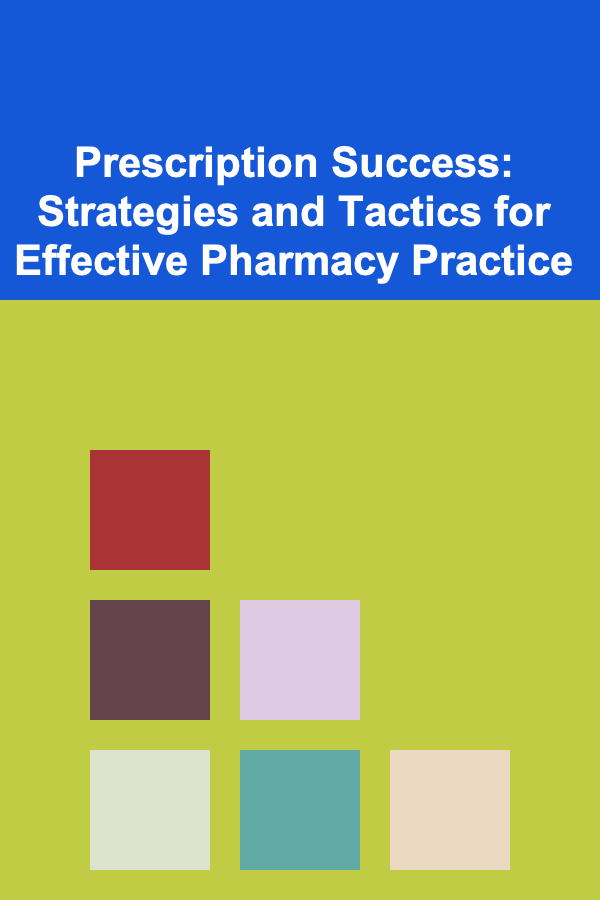
Prescription Success: Strategies and Tactics for Effective Pharmacy Practice
ebook include PDF & Audio bundle (Micro Guide)
$12.99$8.99
Limited Time Offer! Order within the next:

In today's dynamic healthcare landscape, pharmacists are integral to ensuring that patients receive the best possible outcomes from their medications. Whether in community pharmacies, hospitals, or specialized settings, pharmacists must navigate complex drug regimens, maintain a deep understanding of pharmacology, and prioritize patient safety and education. The practice of pharmacy is evolving---focusing not just on dispensing medications but also on promoting wellness, ensuring medication adherence, and mitigating medication errors.
This guide outlines actionable strategies and tactics that pharmacists can adopt to achieve prescription success. These strategies range from improving patient interaction to embracing technological advancements, with a strong focus on the key elements of accuracy, communication, and patient-centered care.
Building a Strong Foundation: Mastering the Basics
a. Accurate Medication Dispensing
Ensuring accurate medication dispensing is the cornerstone of pharmacy practice. A single error in dosage, medication choice, or patient instructions can have severe consequences. Pharmacists must employ robust systems and processes to prevent mistakes.
Actionable Tactics:
- Double-Check Procedures: Always double-check medications and dosages, particularly when dealing with high-risk medications like anticoagulants or chemotherapy agents.
- Leverage Technology: Utilize electronic health records (EHRs) and pharmacy management systems to streamline the dispensing process and cross-check for interactions, allergies, or contraindications.
- Barcoding and Scanning: Employ barcode scanning to confirm medications against patient prescriptions to minimize human error.
b. Understanding Drug Mechanisms and Interactions
Pharmacists should be well-versed in pharmacodynamics (the effects of the drug on the body) and pharmacokinetics (how the body processes the drug). These principles help ensure the safety and efficacy of prescribed medications.
Actionable Tactics:
- Stay Updated with Drug Information: Subscribe to databases and journals to stay current with new drug releases, side effects, and emerging research.
- Use Drug Interaction Checkers: Always use updated drug interaction checkers to monitor for possible adverse interactions, especially when prescribing drugs with narrow therapeutic windows.
Enhancing Patient Counseling and Communication
Pharmacists are not just dispensers of drugs---they are critical educators for patients. Providing clear, concise, and comprehensive counseling helps patients understand how to take their medications, adhere to prescribed regimens, and avoid potential side effects or harmful interactions.
a. Clear Communication about Medication Use
Effective patient counseling begins with clear communication. Patients often struggle with understanding medical terminology or instructions related to their medications.
Actionable Tactics:
- Use Layman's Terms: Avoid using complex medical jargon. Instead, explain the drug's purpose and how to use it in simple terms.
- Written Instructions: Provide written medication guides that outline the drug's name, dosage, side effects, and any special instructions (e.g., take with food, avoid alcohol).
- Visual Aids: Use charts or diagrams to illustrate complex concepts, like how to properly use inhalers, injectables, or other device-assisted medications.
b. Focus on Medication Adherence
Poor adherence to prescribed regimens is a persistent challenge in pharmacy practice. Non-adherence can lead to treatment failure, disease progression, and unnecessary hospitalizations.
Actionable Tactics:
- Assess Adherence Barriers: Ask patients about barriers they face in adhering to their regimen---whether it's due to forgetfulness, side effects, or misunderstanding instructions.
- Offer Medication Management Tools: Recommend medication reminders (e.g., apps, pillboxes) to help patients stay on track.
- Personalized Follow-Up: Schedule regular follow-up calls or visits to check on the patient's progress, adjust therapies as needed, and reinforce adherence.
Leveraging Technology for Efficiency and Safety
The role of technology in pharmacy has expanded rapidly, and embracing digital tools can significantly enhance medication management, improve safety, and increase efficiency.
a. Electronic Health Records (EHRs)
EHRs provide a comprehensive overview of a patient's medical history, including previous prescriptions, allergies, and lab results. These tools help pharmacists make informed decisions, reducing errors and improving overall care.
Actionable Tactics:
- Review Patient History: Before dispensing any prescription, review the patient's EHR to ensure there are no contraindications or interactions with current medications.
- Integrate Pharmacy Software: Use pharmacy-specific software to ensure accurate drug dispensation and keep track of medication inventories, dosages, and refill schedules.
b. Medication Therapy Management (MTM) Systems
MTM systems facilitate a thorough review of a patient's medications to identify and resolve potential issues. These systems allow pharmacists to proactively address concerns like polypharmacy, incorrect drug interactions, or incorrect dosages.
Actionable Tactics:
- Implement MTM Services: Offer MTM consultations to patients with multiple chronic conditions or those on complex drug regimens.
- Document Patient Outcomes: Use MTM platforms to document and track outcomes of consultations, ensuring that changes to the medication regimen are effective and safe.
c. Automated Dispensing and Robotics
Automation has revolutionized prescription filling by speeding up the process and reducing the chance of human error.
Actionable Tactics:
- Incorporate Automation: Invest in automated dispensing systems to improve the speed and accuracy of filling prescriptions, particularly in high-volume settings like hospitals or chain pharmacies.
- Maintain a Human Touch: Even with automation, ensure pharmacists and technicians provide personalized care during patient consultations, and answer any questions regarding the medication.
Managing Medication Therapy and Preventing Errors
Pharmacists need to go beyond dispensing medications by actively managing medication therapy. This proactive approach can improve patient outcomes and prevent medication errors before they happen.
a. Identifying and Preventing Medication Errors
Medication errors can occur at any stage---prescribing, dispensing, or administering. Pharmacists must work closely with other healthcare providers to mitigate these risks.
Actionable Tactics:
- Review Prescriptions Thoroughly: Double-check prescriptions for common errors such as dosage mistakes, drug interactions, and incorrect patient information.
- Collaborate with Prescribers: If there is any ambiguity in a prescription, always reach out to the prescribing healthcare provider for clarification. It's better to ask than to risk an error.
- Risk Management Protocols: Develop and follow institutional protocols for high-risk medications (e.g., anticoagulants, opioids), ensuring correct administration and monitoring.
b. Monitoring for Adverse Drug Reactions (ADRs)
Even with proper administration, ADRs can occur. Pharmacists play a key role in identifying and managing ADRs, ensuring that patients receive the necessary care promptly.
Actionable Tactics:
- Pharmacovigilance: Implement regular monitoring for ADRs and encourage patients to report any unusual side effects.
- Report ADRs: Use established channels to report serious ADRs to regulatory authorities like the FDA. This helps in tracking drug safety at a national level.
Special Populations: Tailoring Medications for Specific Needs
Pharmacists often work with diverse patient populations, each with unique medication needs. Tailoring prescriptions for specific groups such as children, elderly patients, pregnant women, or individuals with chronic conditions is essential for achieving successful outcomes.
a. Pediatric and Geriatric Populations
Children and the elderly often require adjustments in drug dosing due to differences in metabolism, absorption, and elimination. Understanding the specific needs of these populations is crucial.
Actionable Tactics:
- Adjust Dosing for Children: Use weight-based dosing for pediatric patients and choose liquid formulations when applicable.
- Monitor Polypharmacy in the Elderly: Elderly patients may be on multiple medications. Regularly review their prescriptions to prevent potential drug-drug interactions, and adjust doses to prevent adverse effects.
b. Pregnant and Lactating Patients
Pregnancy and breastfeeding present unique challenges when it comes to medication safety. Pharmacists need to be aware of which medications are safe during these periods.
Actionable Tactics:
- Assess Medication Safety: Refer to pregnancy safety categories and lactation guidelines to ensure prescribed medications are safe for use during pregnancy and breastfeeding.
- Avoid Harmful Drugs: Counsel patients on the potential risks of using certain drugs during pregnancy or lactation, and if necessary, suggest alternatives that are safer.
Building Trust and Long-Term Relationships with Patients
The foundation of effective pharmacy practice lies in building lasting relationships with patients. Trust is key to ensuring patients follow prescribed regimens, report side effects, and seek advice when needed.
a. Active Listening and Empathy
Patients are more likely to follow your advice if they feel understood and respected. Building rapport and demonstrating empathy is essential in fostering long-term relationships.
Actionable Tactics:
- Engage in Active Listening: Take the time to listen to patients' concerns, whether they relate to side effects, financial difficulties, or misunderstandings about the medication.
- Be Patient-Centered: Always put the patient's needs first. When possible, discuss treatment options and involve patients in decision-making.
b. Provide Consistent Follow-Up
Pharmacists who follow up with patients show that they care about the patient's well-being beyond just the prescription.
Actionable Tactics:
- Schedule Regular Check-Ins: Call or message patients to follow up on their medication adherence, any side effects, or potential improvements in their condition.
- Create a Supportive Environment: Provide resources, such as brochures or websites, to help patients better understand their medications and manage their health.
Conclusion
Effective pharmacy practice requires a multi-faceted approach that combines technical expertise, patient-centered care, and ongoing communication. By focusing on accuracy, technology integration, medication therapy management, and patient counseling, pharmacists can significantly improve patient outcomes. Staying current with medical advancements, adopting new technologies, and fostering strong relationships with patients are the key strategies for achieving prescription success. The evolving role of pharmacists demands both technical proficiency and a commitment to the well-being of the communities they serve.

Handmade with Love: Simple and Beautiful DIY Gift Ideas
Read More
How to Create a Document Organization App Workflow
Read More
How to Remodel Your Home to Make It More Family-Friendly
Read More
How To Create Hand-Lettering and Calligraphy Designs
Read More
How to Knit Socks for Difficult Feet: A Detailed Guide
Read More
10 Tips for Building a Home Recording Studio on a Budget
Read MoreOther Products

Handmade with Love: Simple and Beautiful DIY Gift Ideas
Read More
How to Create a Document Organization App Workflow
Read More
How to Remodel Your Home to Make It More Family-Friendly
Read More
How To Create Hand-Lettering and Calligraphy Designs
Read More
How to Knit Socks for Difficult Feet: A Detailed Guide
Read More